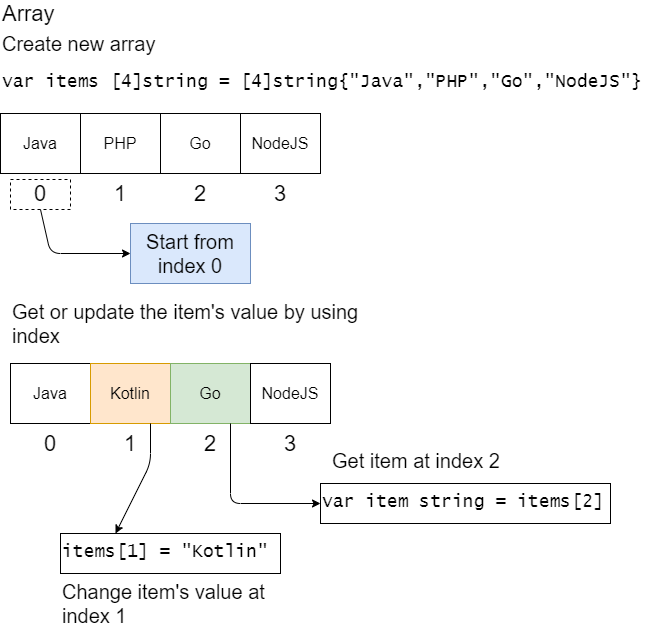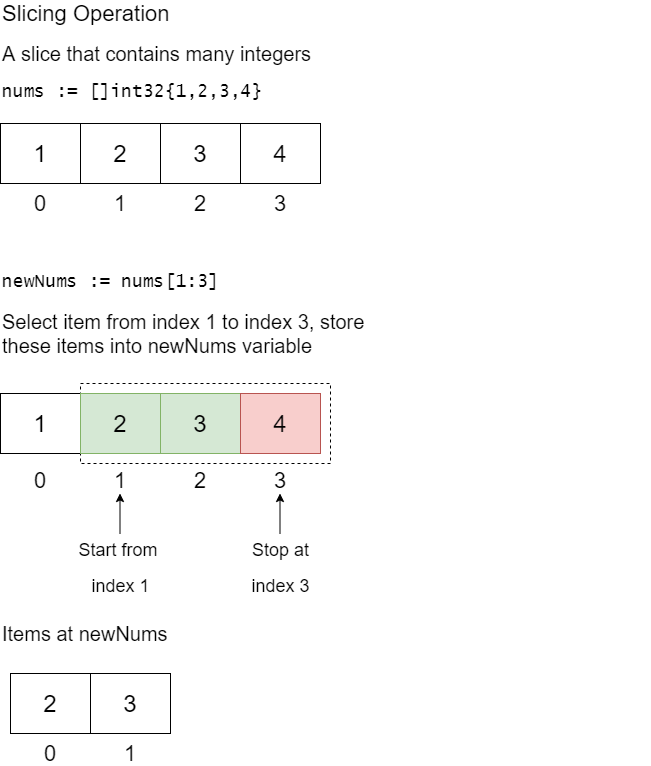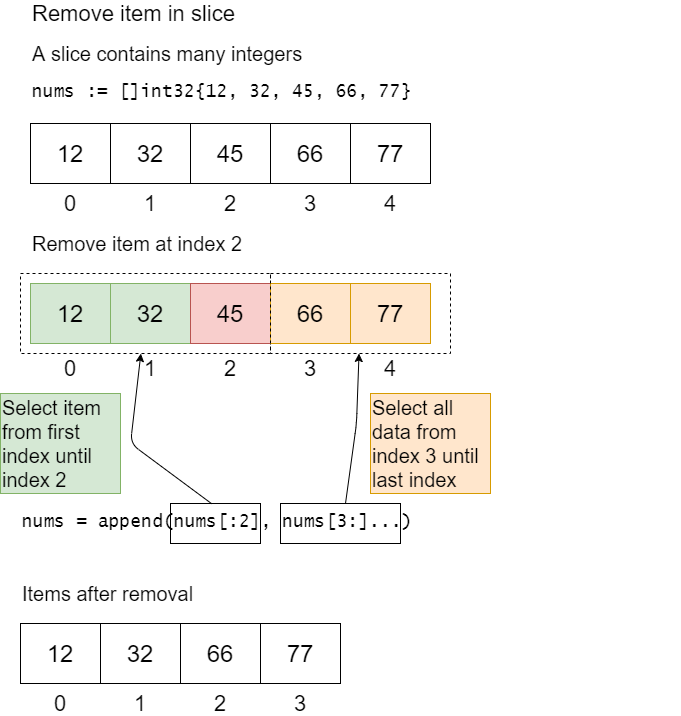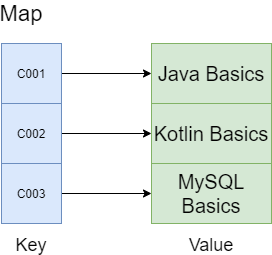Built-in Data Structures in Go with Examples
Data structures in Go Lang, Array,slice and maps. Create slice, map and array
In this Go tutorial series we are going to learn about Data structures. Data structure is a component that can be used to store many data. Not only that, data structure can be used to solve many problems. There are many built-in data structures in Go including array, slice and map.
Array
Array is a data structure that has a fixed size. This is the basic syntax to create an array.
[size]data_type{}
|
Array is illustrated in this picture below.
 |
How do i create array of integers in Go Lang?
In this example, the array of integers is created.
package main import "fmt" func main() { // create an array of integers var myArr [3]int = [3]int{1, 2, 3} // access the item at index 1 fmt.Println("Item at index 1: ", myArr[1]) // change the item at index 2 myArr[2] = 6 fmt.Println("all items") // show all items inside array // using for range for _, item := range myArr { fmt.Println(item) } } |
Output
Item at index 1: 2
all items
1
2
6
Based on the code above, the array of integers is created in myArr variable. The item at index 1 is accessed then printed out. The item at index 2 is changed then all the items inside array is shown using for range.
Slice
Slice is a data structure that similar with array but has a flexible size. This is the basic syntax to create a slice.
[]data_type |
The slice can be created by using make() function.
make([]data_type, size) |
In this example, the slice of strings is created.
package main import "fmt" func main() { // create a slice of strings var courses []string = []string{"Data Science", "Algorithm", "Computer Network", "Database Design"} // access the item at index 2 fmt.Println("Item at index 2: ", courses[2]) // change the item at index 1 courses[1] = "Algorithm with Java" // add new item with append() function courses = append(courses, "Machine Learning") // show all items inside slice // using for range fmt.Println("All courses") for _, course := range courses { fmt.Println(course) } } |
Output
Item at index 2: Computer Network
All courses
Data Science
Algorithm with Java
Computer Network
Database Design
Machine Learning
Based on the code above, the slice of strings is created called courses. The item at index 2 is accessed then the item at index 1 is changed. The new item is added with append() function then all items is shown using for range.
In slice, some items can be selected using slicing operation. The slicing operation is illustrated in this picture below.
 |
In this example, the slicing operation is used to select the items from index 1 to index 3.
package main import "fmt" func main() { // create a slice of strings var langs []string = []string{"Go", "Java", "NodeJS", "PHP", "Python"} // select the items from index 1 to index 3 // then store these items in selected variable var selected []string = langs[1:3] // show all selected items fmt.Println("Selected items") for _, item := range selected { fmt.Println(item) } } |
Output
Selected items
Java
NodeJS
Based on the code above, the item from index 1 to index 3 is selected.
How do i Remove item from slice in go lang
The item inside slice can be removed. This is the example of item removal in slice.
package main import "fmt" func main() { // create a slice of integers var nums []int32 = []int32{12, 32, 45, 66, 77} // remove item at index 2 nums = append(nums[:2], nums[3:]...) // show all items after removed fmt.Println("after removed at index 2") for _, num := range nums { fmt.Println(num) } } |
Output
after removed at index 2
12
32
66
77
Based on the code above, there are many steps to remove an item at index 2.
-
Select the items from the beginning until index 2, because item at index 2 will be removed.
-
Select the items from index 3 until the last index.
-
Combine these selected items using
append()function.
Notice that, in the nums[3:]... syntax there is a ... operator. This operator is used to spread or pick all items from slice. This operator works similar with spread operator in JavaScript.
The item removal mechanism in slice is illustrated in this picture below.
 |
How do i create multi dimensional slice with go lang?
The multi dimensional slice can be created. In this example, the multi dimensional slice is created.
package main import "fmt" func main() { // create a multi dimensional slice var nums [][]int = [][]int{ {1, 2, 3}, {4, 5, 6}, {7, 8, 9}, } // multiply each item inside slice by 3 // using nested for range for _, items := range nums { for _, item := range items { item *= 3 // print out the item that is multiplied fmt.Println(item) } } } |
Output
3
6
9
12
15
18
21
24
27
Map
Map is a data structure that can be used to store key value pairs. The map data structure is illustrated in this picture below.
 |
This is the basic syntax to create a map.
map[key_type]value_type |
In this example, the map is created.
package main import "fmt" func main() { var data map[string]string = map[string]string{ "name": "nathan mckane", "address": "fairhaven", "email": "nathan@mail.com", } // get the item with key equals name fmt.Println("name: ", data["name"]) // change the value for email data["email"] = "nathan@rvwest.com" // print out all values from map fmt.Println("values from map") for key, val := range data { fmt.Println(key, ": ", val) } } |
Output
name: nathan mckane
values from map
address : fairhaven
email : nathan@rvwest.com
name : nathan mckane
Based on the code above, the map is created in data variable with key type is string and value type is string. The value from name key is accessed. The value from email key is changed. The all values from map is printed out using for range.
The value inside map can be removed using delete() function. In this example, the value is removed inside map.
package main import "fmt" func main() { var data map[string]string = map[string]string{ "name": "nathan mckane", "address": "fairhaven", "email": "nathan@mail.com", } // the value with key equals address is removed delete(data, "address") fmt.Println("after address is removed") for key, val := range data { fmt.Println(key, ": ", val) } } |
Output
after address is removed
email : nathan@mail.com
name : nathan mckane
Based on the code above, the delete() function is used with map name and key that will be removed.
In this example, the map is used to store a frequency from each letters or characters in string.
package main
import (
"fmt"
"strings"
)
func main() {
// create a sample string
var text string = "this is sample text"
// split the string
var letters []string = strings.Split(text, "")
// create a map
// to store many frequencies from each letter inside string
var frequencies map[string]int = map[string]int{}
// calculate the frequency for each letter
for _, letter := range letters {
// calculate for valid only letter
if letter != " " {
frequencies[letter] = getFrequency(letters, letter)
}
}
// print out the frequency from each letter
fmt.Println("frequencies")
for key, val := range frequencies {
fmt.Println(key, ": ", val)
}
}
// create a function to calculate frequency
// for certain letter
func getFrequency(letters []string, char string) int {
var result int = 0
for _, letter := range letters {
if letter == char {
result++
}
}
return result
}
|
Output
frequencies
h : 1
s : 3
a : 1
m : 1
l : 1
t : 3
p : 1
e : 2
x : 1
i : 2
Conclusions
-
Array is suitable to store many items with fixed size.
-
Slice is suitable to store many items with flexible size.
-
Map is suitable to store many key value pairs.
I hope this article is helpful to learn built-in data structures in Go Programming Language.